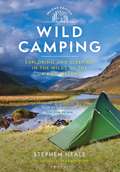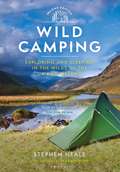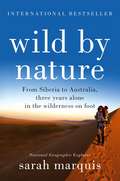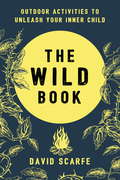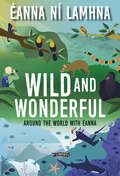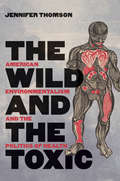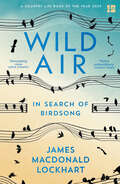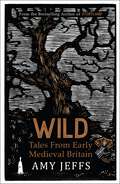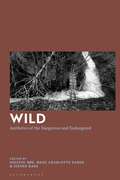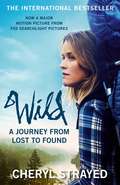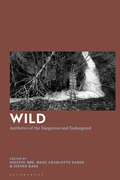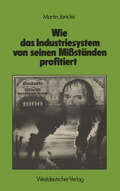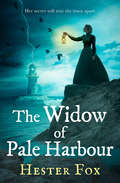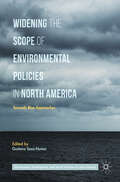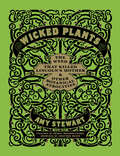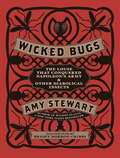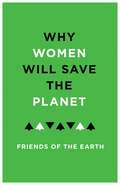- Table View
- List View
Wild Camping: Exploring and Sleeping in the Wilds of the UK and Ireland
by Stephen NealeFrom getting back to nature with a tent, some matches and a few litres of bottled water, to enjoying a pub dinner and camping out in the garden afterwards, this book shows how to get stuck into wild camping in all its forms. Beautiful wildernesses; tiny budgets; environmentally-friendly… What's not to like?There's an idea that wild camping is illegal in Britain, but it isn't – you just need to know the rules and where to go. This guide will open up this amazing experience for all, covering: - what is wild camping and why bother? - different types (bivvying, tenting, hammocking, on the water) - what the law says (Scotland, England, Northern Ireland, Wales, Ireland, EU, waterways) - how many of the largest landowners in the UK are actively encouraging wild camping - getting started (vital equipment, where to go, when to go, safety) - drinking water and foraging for food The majority of the book features the best places to go in England, Wales, Ireland and Scotland, along with stories, tips, helpful maps and inspiring photos. The new edition includes a Foreword by Ed Stafford, as well as a completely new chapter introducing the exciting new English Coastal Path, opening 2020 after years of campaigning. This fully updated guide will give readers the knowledge and the inspiration to escape the noise, clutter and stress of day to day life and go wild.
Wild Camping: Exploring and Sleeping in the Wilds of the UK and Ireland
by Stephen NealeFrom getting back to nature with a tent, some matches and a few litres of bottled water, to enjoying a pub dinner and camping out in the garden afterwards, this book shows how to get stuck into wild camping in all its forms. Beautiful wildernesses; tiny budgets; environmentally-friendly… What's not to like?There's an idea that wild camping is illegal in Britain, but it isn't – you just need to know the rules and where to go. This guide will open up this amazing experience for all, covering: - what is wild camping and why bother? - different types (bivvying, tenting, hammocking, on the water) - what the law says (Scotland, England, Northern Ireland, Wales, Ireland, EU, waterways) - how many of the largest landowners in the UK are actively encouraging wild camping - getting started (vital equipment, where to go, when to go, safety) - drinking water and foraging for food The majority of the book features the best places to go in England, Wales, Ireland and Scotland, along with stories, tips, helpful maps and inspiring photos. The new edition includes a Foreword by Ed Stafford, as well as a completely new chapter introducing the exciting new English Coastal Path, opening 2020 after years of campaigning. This fully updated guide will give readers the knowledge and the inspiration to escape the noise, clutter and stress of day to day life and go wild.
Wild by Nature: From Siberia to Australia, Three Years Alone in the Wilderness on Foot
by Sarah MarquisIn 2010, Sarah Marquis embarked on a perilous journey: alone and on foot, she walked ten thousand miles across the Gobi Desert, from Siberia, through Thailand, to the Australian outback.Relying on hunting and her own wits, she traversed fever-haunted jungles and scorching deserts, braved harassment from drug dealers, the Mafia, and camp raids from thieves on horseback. Surviving dehydration, dengue fever delirium and crippling infection, Sarah experienced a raw and spiritual communion after three years of walking at the base of a tree in the plains of Australia.Through an inspirational journey, Wild by Nature explores what it is to adventure as a woman in the most dangerous of circumstances, and what it is to be truly alone in the wild.
Wild by Design: The Rise of Ecological Restoration
by Laura J. MartinAn environmental historian delves into the history, science, and philosophy of a paradoxical pursuit: the century-old quest to design natural places and create wild species. Environmental restoration is a global pursuit and a major political concern. Governments, nonprofits, private corporations, and other institutions spend billions of dollars each year to remove invasive species, build wetlands, and reintroduce species driven from their habitats. But restoration has not always been so intensively practiced. It began as the pastime of a few wildflower enthusiasts and the first practitioners of the new scientific discipline of ecology. Restoration has been a touchstone of US environmentalism since the beginning of the twentieth century. Diverging from popular ideas about preservation, which romanticized nature as an Eden to be left untouched by human hands, and conservation, the managed use of natural resources, restoration emerged as a “third way.” Restorationists grappled with the deepest puzzles of human care for life on earth: How to intervene in nature for nature’s own sake? What are the natural baselines that humans should aim to restore? Is it possible to design nature without destroying wildness? Laura J. Martin shows how, over time, amateur and professional ecologists, interest groups, and government agencies coalesced around a mode of environmental management that sought to respect the world-making, and even the decision-making, of other species. At the same time, restoration science reshaped material environments in ways that powerfully influenced what we understand the wild to be. In Wild by Design, restoration’s past provides vital knowledge for climate change policy. But Martin also offers something more—a meditation on what it means to be wild and a call for ecological restoration that is socially just.
The Wild Book: Outdoor Activities to Unleash Your Inner Child
by David ScarfeIn a world in which we're never far from our phones or tablets, computers or consoles, we can often be blind to the joy that can be found in the great outdoors. We're building worlds in Minecraft when we could be building a raft; we're watching the latest Netflix show when we could be gazing at the stars; we're idly scrolling on social media when we could be strolling through woodlands; we're internet shopping when we could be panning for gold.Our phones may be smarter, but our experiences have shrunk down to the size of the screens in front of our eyes. The Wild Book is here to re-acquaint us with the wonders that await in the outside world. Beautifully produced, full of fun, easy-to-do games and activities - including how to make sloe gin, climb trees, build a fire, identify different cloud formations and make a shelter - this is the ultimate book to unleash your inner child.
The Wild Beyond: Book 3 (The Last Wild Trilogy #3)
by Piers TordayAS SEEN ON BBC'S COUNTRYFILEFROM THE WINNER OF THE GUARDIAN CHILDREN'S FICTION PRIZE A thrilling animal adventure for fans of Roald Dahl, David Walliams and Katherine RundellThis is the story of a boy named Kester. He has rescued the last wild animals in the world, and saved his capital city from destruction. But now he must face his greatest challenge yet, because:1. The only blue whale on the planet has brought news from across the ocean2. A mysterious steel dome has risen from the Four Towers3. Out there, somewhere, a brave mouse holds the key to the future...
Wild and Wonderful: Around the World with Éanna
by Éanna Ní LamhnaGlow-in-the-dark owls, eggs boiling in Icelandic hot pools, the gangster tactics of the devil’s coach-horse beetle … Éanna Ní Lamhna has seen them all! Éanna explores the wonders of our wild world, from a safari in Tanzania to the cloud forests of Costa Rica, from rat-hunting in Canada to whale watching in New Zealand. She draws on her experience as a diver to tell of face-to-face encounters with fascinating fan worms, elusive sea hares and a murderous crab, and rings the alarm bells on the environmental challenges facing us. Éanna also recounts with cheerful relish the pitfalls and delights of being a broadcaster and a scientist. Sure why would anyone want to be anything else?
The Wild and the Toxic: American Environmentalism and the Politics of Health
by Jennifer ThomsonHealth figures centrally in late twentieth-century environmental activism. There are many competing claims about the health of ecosystems, the health of the planet, and the health of humans, yet there is little agreement among the likes of D.C. lobbyists, grassroots organizers, eco-anarchist collectives, and science-based advocacy organizations about whose health matters most, or what health even means. In this book, Jennifer Thomson untangles the complex web of political, social, and intellectual developments that gave rise to the multiplicity of claims and concerns about environmental health. Thomson traces four strands of activism from the 1970s to the present: the environmental lobby, environmental justice groups, radical environmentalism and bioregionalism, and climate justice activism. By focusing on health, environmentalists were empowered to intervene in the rise of neoliberalism, the erosion of the regulatory state, and the decimation of mass-based progressive politics. Yet, as this book reveals, an individualist definition of health ultimately won out over more communal understandings. Considering this turn from collective solidarity toward individual health helps explain the near paralysis of collective action in the face of planetary disaster.
Wild Air: In Search of Birdsong
by null James Macdonald LockhartLonglisted for the 2023 Highland Book Prize ‘Joyful and mindful, a powerful argument for being still and listening’ Sunday Times A book about birds, birdsong and the countryside they inhabit, from the critically acclaimed author of Raptor. In Wild Air, James Macdonald Lockhart sets out to write about a series of birds as though he has his granny’s role of listening to birds’ songs and calls and relaying what she heard to her aged and by then quite deaf father – the famous naturalist Seton Gordon. From a nightjar’s strange churring song on a heath in the south of England, to a lapwing displaying over the machair in the Outer Hebrides, he writes about eight different birds who he has spent most time with, returned to most often and relays what he hears.The eight species are all representative of a different habitat. Nightjars on a lowland heath; shearwaters on a mountain overlooking the sea; dippers on a river; skylarks in farmland; ravens in woodland; divers on a loch; lapwings on the coast; and nightingales in dense scrub. Not all of the birds are songbirds in the traditional sense, though each possesses its own distinctive music. That music can vary from the strange, as in the weird gurgling sound a shearwater makes inside its burrow, to the joyous exuberance of the skylark’s song. Sometimes, he hears a lot, and sees little (shearwaters in the pitch dark); sometimes he sees a lot, but hears little (black-throated divers on their loch). But in every case the sounds the birds make become an introduction to their lives – an audible introduction to the birds and the places they are found.
Wild: A Gripping Rainforest Adventure From The Multi Award-winning Author Of Refugee 8 7
by Ele FountainA moving, page-turning novel about a family's grief and the crisis afflicting the rainforest, from the prize-winning author of Boy 87 and FakeEver since Jack's dad died, he's had a heavy feeling inside. The pressure keeps building. Looking for release, he starts skiving school and hanging around with a group who like to cause trouble. It's easy to hide his new habits from his mum, an environmental anthropologist, because she's too busy with work and conservation trips to notice.As Jack spins further out of control, his mum eventually becomes concerned - and shocks him by suggesting a trip together.But this will be no relaxing holiday. Soon Jack finds himself on an expedition deep into the rainforest, far from anything he's ever known. He wanted an adventure - but has he plunged into real danger?
Wild: Tales from Early Medieval Britain
by Amy JeffsBy the bestselling author of Storyland.Sheer cliffs, salt spray, explosive sea spume, thunderous clouds, icy waves, whales with mountains on their backs, sleet, bitter winds, bleak, impenetrable marshes, howling wolves, forests, the unceasing cries of birds and the death grip of subterranean vaults that have never seen the sun: these are wild landscapes of a world almost familiar.In Wild, Amy Jeffs journeys - on foot and through medieval texts - from landscapes of desolation to hope, offering the reader an insight into a world at once distant and profoundly close to home. The seven chapters, entitled Earth, Ocean, Forest, Beast, Fen, Catastrophe, Paradise, open with fiction and close with reflection. They blend reflections of travels through fen, forest and cave, with retelling of medieval texts that offer rich depictions of the natural world. From the Old English elegies to the englynion and immrama of the Celtic world - stories that largely represent figures whose voices are not generally heard in the corpus of medieval literature: women, outcasts, animals.Illustrated with original wood engravings, evoking an atmospheric world of whales, wolves, caves, cuckoos and reeds, Wild: Tales From Early Medieval Britain will leave readers feeling 'westendream': delight in the wilderness.
Wild: Aesthetics of the Dangerous and Endangered
by Solveig Bøe, Hege Charlotte Faber and Eivind KasaIn this interdisciplinary work, philosophers from different specialisms connect with the notion of the wild today and interrogate how it is mediated through the culture of the Anthropocene. They make use of empirical material like specific artworks, films and other cultural works related to the term 'wild' to consider the aesthetic experience of nature, focusing on the untamed, the boundless, the unwieldy, or the unpredictable; in other words, aspects of nature that are mediated by culture. This book maps out the wide range of ways in which we experience the wildness of nature aesthetically, relating both to immediate experience as well as to experience mediated through cultural expression. A variety of subjects are relevant in this context, including aesthetics, art history, theology, human geography, film studies, and architecture. A theme that is pursued throughout the book is the wild in connection with ecology and its experience of nature as both a constructive and destructive force.
Wild: A Journey from Lost to Found
by Cheryl StrayedSelected to be read on Radio Four's Book of the Week. 'One of the best books I've read in the last five or ten years... Wild is angry, brave, sad, self-knowing, redemptive, raw, compelling, and brilliantly written, and I think it's destined to be loved by a lot of people, men and women, for a very long time.' --Nick HornbyAt twenty-six, Cheryl Strayed thought she had lost everything. In the wake of her mother's rapid death from cancer, her family disbanded and her marriage crumbled. With nothing to lose, she made the most impulsive decision of her life: to walk eleven-hundred miles of the west coast of America - from the Mojave Desert, through California and Oregon, and into Washington state - and to do it alone. She had no experience of long-distance hiking and the journey was nothing more than a line on a map. But it held a promise - a promise of piecing together a life that lay in ruins at her feet. Strayed's account captures the agonies - both mental and physical - of her incredible journey; how it maddened and terrified her, and how, ultimately, it healed her. Wild is a brutal memoir of survival, grief and redemption: a searing portrayal of life at its lowest ebb and at its highest tide.
Wild: Aesthetics of the Dangerous and Endangered
In this interdisciplinary work, philosophers from different specialisms connect with the notion of the wild today and interrogate how it is mediated through the culture of the Anthropocene. They make use of empirical material like specific artworks, films and other cultural works related to the term 'wild' to consider the aesthetic experience of nature, focusing on the untamed, the boundless, the unwieldy, or the unpredictable; in other words, aspects of nature that are mediated by culture. This book maps out the wide range of ways in which we experience the wildness of nature aesthetically, relating both to immediate experience as well as to experience mediated through cultural expression. A variety of subjects are relevant in this context, including aesthetics, art history, theology, human geography, film studies, and architecture. A theme that is pursued throughout the book is the wild in connection with ecology and its experience of nature as both a constructive and destructive force.
Wie der Mensch seine Welt neu erschaffen hat
by Ernst Peter Fischer„Wissenschaft wird von Menschen gemacht“Mit diesem Zitat des Physikers und Humanisten Werner Heisenberg leitet Ernst Peter Fischer sein Buch über die „zweite Erschaffung der Welt“ ein. Seiner Auffassung nach nehmen wir diesen einfachen und an sich selbstverständlichen Satz nicht zur Kenntnis und ernst, wie die Naturforscher mit ihren naturwissenschaftlichen und medizinischen Erträgen seit dem 17. Jahrhundert maßgeblich ihr und damit unser aller gegenwärtiges Leben geprägt und praktisch gestaltet haben. Er schreibt: "Tatsächlich ist es so, dass sich europäische Gesellschaften – nicht zuletzt die deutsche – im frühen 21. Jahrhundert nahezu vollständig und unumkehrbar in Abhängigkeit von wissenschaftlich-technischen Fortschritten etwa bei der Ressourcennutzung, der Energiegewinnung, der Krankenversorgung oder der Kommunikation entfaltet haben. Und ihre Geschichte – ihr Vorwärtsstreben in die derzeitige Lage und ihr Aussehen – kann man nur verstehen, wenn man die dazugehörige Dynamik berücksichtigt, wenn man also die Geschichte der Wissenschaften und der mit ihren Kenntnissen möglichen Technik zur Kenntnis nimmt, die in ihrer relevanten und aktuellen Form im frühen 17. Jahrhundert begonnen und den europäischen Sonderweg zum Wohlstand bereitet hat, den viele Millionen Menschen ganz selbstverständlich in wachsender Zahl genießen, ohne zu fragen, woher er kommt und welchen Ideen sie ihn zu verdanken haben."
Wie das Industriesystem von seinen Mißständen profitiert: Kosten und Nutzen technokratischer Symptombekämpfung: Umweltschutz, Gesundheitswesen, innere Sicherheit
by Martin JänickeThe Widow Of Pale Harbour (Hq Fiction Ebook Ser.)
by Hester Fox‘[This] romance-cum-murder mystery moves at a brisk pace.’ The Sunday Times ‘A perfect blend of gothic mystery, drama and romance.’ Cressida McLaughlin ************************************************************* A town gripped by fear. A woman accused of murder. Who can save Pale Harbour from itself?
Widening the Scope of Environmental Policies in North America: Towards Blue Approaches (Governance, Development, and Social Inclusion in Latin America)
by Gustavo Sosa-NunezThis edited volume provides a variety of insights into the context in which ocean and wetlands policy is placed at the sub-continental level. The governments of Mexico, Canada, and United States of America have recognized the importance of conserving, protecting, and enhancing the environment in their territories. As a result, they have developed an institutional structure aimed at furthering environmental cooperation. However, marine environment has played a secondary role, characterized by scientific cooperation that does not develop into regional policies. This project analyzes how ocean and wetlands preservation is omitted from the North American Agreement on Environmental Cooperation, meaning that collaborative efforts under-perform or remain largely sidelined from mainstream issues. As contributors come from a mix of the social and natural sciences (politics, international relations, law studies, sociology, oceanology, and oceanography), this book presents diverse viewpoints on how to address wetlands protection, deep ocean research collaboration, and the marine context of the Sustainable Development Goals.
Wide Rivers Crossed: The South Platte and the Illinois of the American Prairie
by Ellen E. WohlIn Wide Rivers Crossed, Ellen Wohl tells the stories of two rivers—the South Platte on the western plains and the Illinois on the eastern—to represent the environmental history and historical transformation of major rivers across the American prairie. Wohl begins with the rivers’ natural histories, including their geologic history, physical characteristics, ecological communities, and earliest human impacts, and follows a downstream and historical progression from the use of the rivers’ resources by European immigrants through increasing population density of the twentieth century to the present day. During the past two centuries, these rivers changed dramatically, mostly due to human interaction. Crops replaced native vegetation; excess snowmelt and rainfall carried fertilizers and pesticides into streams; and levees, dams, and drainage altered distribution. These changes cascaded through networks, starting in small headwater tributaries, and reduced the ability of rivers to supply the clean water, fertile soil, and natural habitats they had provided for centuries. Understanding how these rivers, and rivers in general, function and how these functions have been altered over time will allow us to find innovative approaches to restoring river ecosystems. The environmental changes in the South Platte and the Illinois reflect the relentless efforts by humans to control the distribution of water: to enhance surface water in the arid western prairie and to limit the spread of floods and drain the wetlands along the rivers in the water-abundant east. Wide Rivers Crossed looks at these historical changes and discusses opportunities for much-needed protection and restoration for the future.
Wide-awake Hedgehog
by Rosie WellesleyIsaac, the lovable hedgehog, isn't sleepy. In fact, he's quite the opposite – he's wide awake and wants to play. However, autumn is coming and all his little friends want to go into hibernation. They are so sleepy and struggling to keep their eyes open!
Wicked Plants: The Weed That Killed Lincoln's Mother and Other Botanical Atrocities
by Amy StewartA tree that sheds poison daggers; a glistening red seed that stops the heart; a shrub that causes paralysis; a vine that strangles; and a leaf that triggered a war. In Wicked Plants, Stewart takes on over two hundred of Mother Nature’s most appalling creations. It’s an A to Z of plants that kill, maim, intoxicate, and otherwise offend. You’ll learn which plants to avoid (like exploding shrubs), which plants make themselves exceedingly unwelcome (like the vine that ate the South), and which ones have been killing for centuries (like the weed that killed Abraham Lincoln's mother). Menacing botanical illustrations and splendidly ghastly drawings create a fascinating portrait of the evildoers that may be lurking in your own backyard. Drawing on history, medicine, science, and legend, this compendium of bloodcurdling botany will entertain, alarm, and enlighten even the most intrepid gardeners and nature lovers.
Wicked Environmental Problems: Managing Uncertainty and Conflict
by Peter J. Balint Ronald E. Stewart Anand Desai Lawrence C. WaltersThis new book examines past experience and future directions in the management of so-called "wicked" environmental problems-those characterized by large-scale, long-term policy dilemmas and contentious political stalemates. Most important, the book reviews current thinking on the way forward, focusing on the implementation of "learning networks," in which public managers, technical experts, and public stakeholders collaborate in decision-making processes that are analytic, iterative, and deliberative. Wicked Environmental Problems offers new approaches for managing environmental conflicts and shows how managers could apply these approaches within common, real-world statutory decision-making frameworks. It is essential reading for anyone concerned with managing environmental problems.
Wicked Bugs: The Louse That Conquered Napoleon's Army & Other Diabolical Insects
by Amy StewartIn this darkly comical look at the sinister side of our relationship with the natural world, Stewart has tracked down over one hundred of our worst entomological foes—creatures that infest, infect, and generally wreak havoc on human affairs. From the world&’s most painful hornet, to the flies that transmit deadly diseases, to millipedes that stop traffic, to the &“bookworms&” that devour libraries, to the Japanese beetles munching on your roses, Wicked Bugs delves into the extraordinary powers of six- and eight-legged creatures. With wit, style, and exacting research, Stewart has uncovered the most terrifying and titillating stories of bugs gone wild. It&’s an A to Z of insect enemies, interspersed with sections that explore bugs with kinky sex lives (&“She&’s Just Not That Into You&”), creatures lurking in the cupboard (&“Fear No Weevil&”), insects eating your tomatoes (&“Gardener&’s Dirty Dozen&”), and phobias that feed our (sometimes) irrational responses to bugs (&“Have No Fear&”). Intricate and strangely beautiful etchings and drawings by Briony Morrow-Cribbs capture diabolical bugs of all shapes and sizes in this mixture of history, science, murder, and intrigue that begins—but doesn&’t end—in your own backyard.
Why Women Will Save the Planet
by Bloomsbury PublishingCities across the globe are growing fast. Today many are environmental nightmares with polluted air, excessive energy consumption and an absence of nature. But big cities don't have to mean a dystopian future. They can be turned around to be powerhouses of well-being and environmental stability – if we empower women.This book is a unique collaboration between C40 and Friends of the Earth showcasing pioneering voices in the environmental and feminist movements. This book reveals just how women's empowerment is critical to environmental sustainability. This book is a rallying call – for the planet, for women, for everyone.
